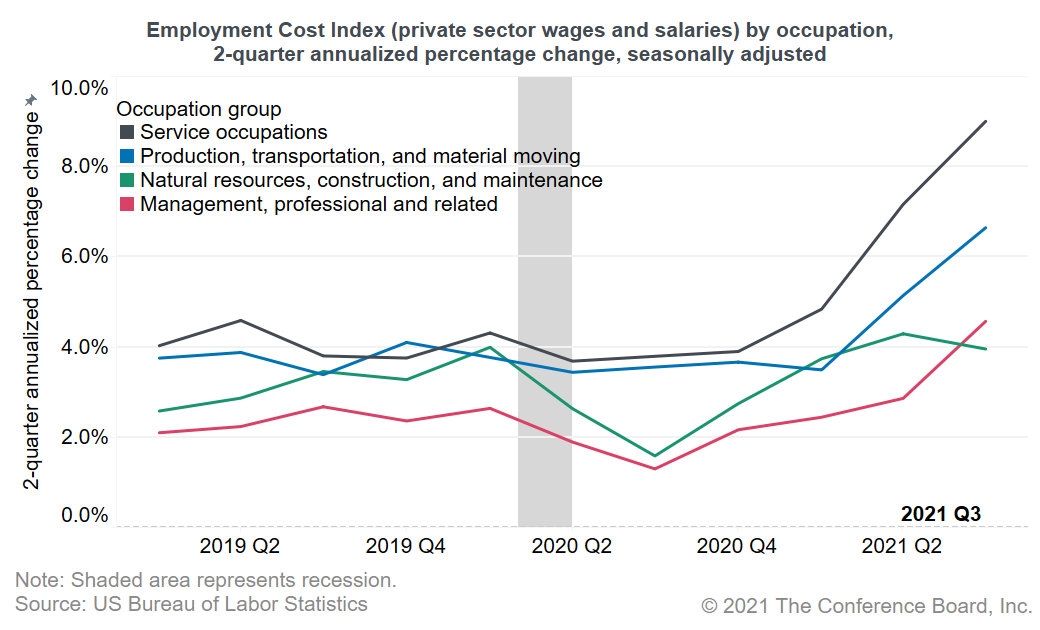-
Email
Linkedin
Facebook
Twitter
Copy Link

Loading...
The Q3 Employment Cost Index data, released this morning, revealed continued pressure on wages amid labor shortages. These trends may result in upward pressure on consumer prices in the coming months. Wages and salaries for private industry workers increased at a 6.5 percent annualized rate in the three-month period ending in September, a steep increase from an already high 3.9 percent in the previous three months. Over the last six months, the annualized growth rate was 5.2 percent. Services (9.0 percent over six months) and production, transportation and material moving (6.6 percent) occupations led the way, as tight labor markets continue to increase wages in those areas (see chart below). Even management and professional occupations, which have been less impacted by pandemic induced labor shortages, saw wage growth of 4.6 percent after several years of wage growth below 3 percent. This quarter’s data is also marked by an expansion of benefits provided to workers, possibly reflecting firms’ increased efforts at retaining their existing workforce. The monetary value of benefits increased by an annualized rate of 2.7 percent over the six-month period ending in September, with production, transportation and material moving workers (4.0 percent) and manual service workers (3.9 percent) seeing the largest increases. Tight labor markets in manufacturing, in-person services and transportation continue to contribute to rapid growth in compensation. Labor supply constraints remain, and it is uncertain whether they will subside by the end of the year. Increased vaccination rates and vaccine mandates coming into effect should alleviate hesitation to work due to health risks for some. However, these mandates could also push the vaccine hesitant out of the labor force. The expiration of pandemic-related unemployment assistance may result in more people actively seeking work. On the other hand, many older workers who left the labor force since the start of the pandemic may never return and choose to retire instead. Overall, we could see some alleviation in tight labor markets if workers return to the labor market in Q4 2021. After the bulk of labor market re-entrants are hired, however, the labor market could further tighten again by early or mid-2022, leading to further wage pressures.Employment Cost Index report for the 3rd Quarter 2021

Retail Sales Show Consumers Stock Up ahead of Tariffs
April 16, 2025
US Seeks Shipbuilding Revival, Muting of China Dominance
April 14, 2025
March CPI May Hint at Consumer Pullback as Tariffs Rise
April 10, 2025
The US-China Trade War Escalates
April 09, 2025
Charts
Wage inequality continues downward trend in quarter 2 of 2023
LEARN MORECharts
Recent hikes in quits rates indicate retention difficulties across all industries, but have nearly approached pre-pandemic levels
LEARN MORECharts
Decline in office and administrative support work suggests certain tasks and skills have been replaced by automation
LEARN MORECharts
CEOs are having trouble filling positions as the unemployment rate drops lower
LEARN MORECharts
Non-union wages are growing faster than union wages
LEARN MORECharts
This index identifies the risk of future labor shortages for specific occupations.
LEARN MORECharts
Labor shortages and the tightening of labor markets have led companies to lower education requirements when recruiting.
LEARN MORECharts
The rapid rise in job openings to historic highs coupled with increasingly more workers quitting is leading to severe labor shortages, especially in leisure & hospita…
LEARN MORECharts
There has been a large increase in the share of office job ads that mention remote work since before the pandemic.
LEARN MOREPRESS RELEASE
Employment Trends Index™ (ETI) Increased in August
September 09, 2024
PRESS RELEASE
Why the World Is Running Out of Workers
August 13, 2024
PRESS RELEASE
Employment Trends Index™ (ETI) Decreased in July
August 05, 2024
PRESS RELEASE
Employment Trends Index™ (ETI) Decreased in June
July 08, 2024
PRESS RELEASE
Employment Trends Index™ (ETI) Decreased in June
July 10, 2023
PRESS RELEASE
Employment Trends Index™ (ETI) Decreased in May
June 05, 2023
